Download Class 7 Science Control And Coordination Notes in PDF format. All Revision notes for Class 7 Science have been designed as per the latest syllabus and updated chapters given in your textbook for Science in Class 7. Our teachers have designed these concept notes for the benefit of Class 7 students. You should use these chapter wise notes for revision on daily basis. These study notes can also be used for learning each chapter and its important and difficult topics or revision just before your exams to help you get better scores in upcoming examinations, You can also use Printable notes for Class 7 Science for faster revision of difficult topics and get higher rank. After reading these notes also refer to MCQ questions for Class 7 Science given on studiestoday
Revision Notes for Class 7 Science Control And Coordination
Class 7 Science students should refer to the following concepts and notes for Control And Coordination in Class 7. These exam notes for Class 7 Science will be very useful for upcoming class tests and examinations and help you to score good marks
Control And Coordination Notes Class 7 Science
COORDINATION IN ANIMALS
Neuron:-
The basic structural and functional unit of nervous system. Neuron (nerve cell) is the longest of human body (up to 100 cm)
Neuron is made up of-
(i) Cell body
(ii) Cell process (axon and dendron)
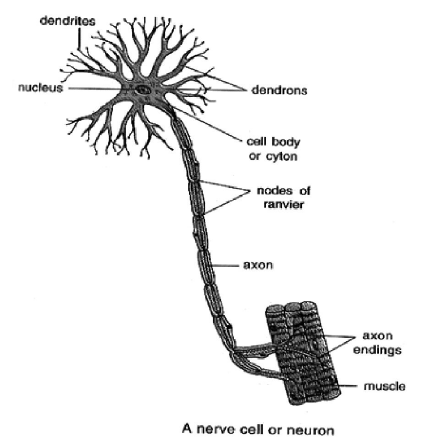
(i) Cell body:- or Cyton or Soma or Perikaryon
- It is broad, rounded, pyriform or stellate part of the neuron that contains a central nucleus, abundant cytoplasm and various cell organelles except centrioles.
- Because of the absence of centriole, neurons cannot divide. Injured neurons are either replaced or repaired.
- Cytoplasm of cell body is also called neuroplasm. Nucleus is large with a prominent nucleolus.
- Special structures present in cell body of a neuron are small ribosome containing Nissl granules and fine fibrils called neurofibrils.
- Cell body maintains the neuron through its metabolic activity andgrowth.
(ii) Cell process:-
(a) Axon:-
- It is a long fibre-like cytoplasmic process that carries impulses away from the cell body.
- Axon is branched terminally. The terminal branches are called telodendria or terminal arborisations.
- Axon terminals may end in muscle fibres, glands, other structures or form synapses with dendrites of other neurons.
- Axon terminals are often knob-like (synaptic knobs or boutons).
- Axon is covered by one or two sheaths. The sheathed axon is called nerve fibre.
- A number of nerve fibres are joined to form a nerve.
- The cell membrane covering the axon is called axolemma.
- Cytoplasm of axon is termed as axoplasm. It lacks Nissl granules. Neurofibrils are present.
- The single sheath present over the axon is made of Schwann cells. It is called neurolemma or neurilemma. If two, a layer of insulating myelin or fat occurs between neurolemma and axon.
- The two types of nerve fibres are respectively called nonmyelinated and myelinated.
- Myelinated fibres are more efficient in transmission of impulses than nonmyelinated fibres. At intervals they bear unmyelinated areas called nodes of Ranvier.
(b) Dendron:-
- They are fine short and branched protoplasmic processes of the cell body that pick up sensations (physical, mechanical, electrical, chemical) and transmit the same to the cell body.
- Dendrites contain Nissl granules and neurofibrils.
Types of Neurons:-
The neurons are of three types:
(i) Sensory (receptor) neurons:- Sensory organ to CNS
(ii) Motor (effector) neurons :- CNS to effector organ
(iii) Relaying (connector) neurons:- Joins sensory to motor neuron
Synapse: The junction between two adjacent neurons i.e. betwen the axon ending of one neuron and dendrites of the next.
Nerve impulse:- It is an electro-chemical information (signal) passing through neuron.
Neurotransmitters or Neurohormones:- Chemical substances which either transmit or inhibit the message from one neuron to another.Ex- Acetyl choline (Ach), GABA
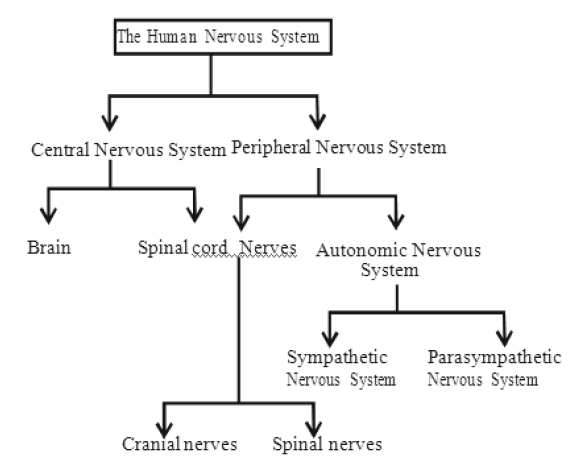
Central Nervous System (CNS):-
CNS consits of the brain and the spinal cord.
(A) Brain
- Brain is the most important part of human body.
- Brain is situated in a cranial box (cranium) which is made up of bones.
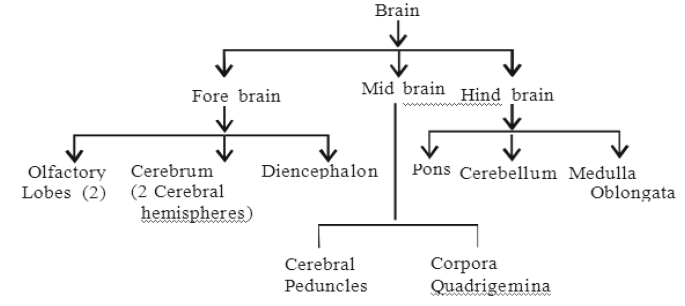
(1) Forebrain (Prosencephalon):-
(a) Cerebrum (Telencephalon):-
- It is highly developed in man and constitutes about 2/ 3rd of the brain.
- It is divided into right and left halves. The two halves are separated by a deep median groove.
- Large bundles of nerves called corpus callosum connect both halves of the cerebrum.
- The surface of the cerebrum shows many folds and grooves called gyri and sulci, which increase the surface area to accommodate large number of nerve cells.
- Each cerebral hemisphere is divided into 4 lobes-
(i) Anterior:- Frontal lobe for intelligence, knowledge, abstract, reasoning, creative ideas and memory.
(ii) Middle:- Parietal lobe for taste, writing, pain, touch and pressure.
(iii) Lateral:- Temporal lobe for language, hearing and smell.
Posterior:- Occipital lobe meant for vision
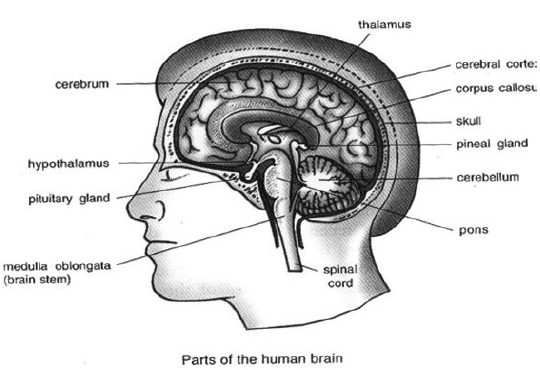
(a) Diencephalon:-
(i) Thalamus:-
- They act as relay station.
- They receive all sensory impulse from all parts of the body and theseimpulse are send
to the cerebral hemispheres.
(ii) Hypothalamus:-
Function:-
(i) Thermoregulation
(ii) Behaviour and emotion
(iii) Endocrine control
(iv) Biological clock system
(v) There are centres of temperature control, pain, hunger and thirst.
(2) Mid brain (Mesencephalon):-
(a) Cerebral peduncles (Crura cerebri):-
It controls the limb muscle movement.
(b) Optic lobes (Corpora Quadrigemina):- These mainly control vision.
(3) Hind Brain (Rhombencephalon):-
(a) Pons or Pons Varolii :-
It regulates the breathing reaction.
(b) Cerebellum:-
Function:- It is related with body balance & posture.
(c) Medulla oblongata:
Function:-
- It controls all the involuntary activities of the body. e.g. heart beat, respiration.
- It also concerned with some reflexessneezing reflex, coughingreflex, vomiting reflex, yawning reflex.
Cavities of brain (Ventricles):-
Human brain is hollow. Hollow part of brain is called ventricle. In brain, 4 ventricles are present. Ventricles are filled with a fluid called cerebrospinal fluid.
(B) Spinal Cord
It is a downward continuation of the medulla oblongata, which lies in the vertebral column.
Function of spinal cord-
(i) Spinal cord regulates and conducts the reflex action.
(ii) It acts as bridge between brain & organs of the body.
(iii) It also provides relay path for the impulses coming from brain.
Reflex Actions
“Marshal Hall” first observed the reflex actions. Reflex actions are spontaneous, automatic, involuntary, mechanical responses produced by specific stimulating receptors. The path of completion of reflex action is called “reflex arc”.
A typical reflex action has the following pathway
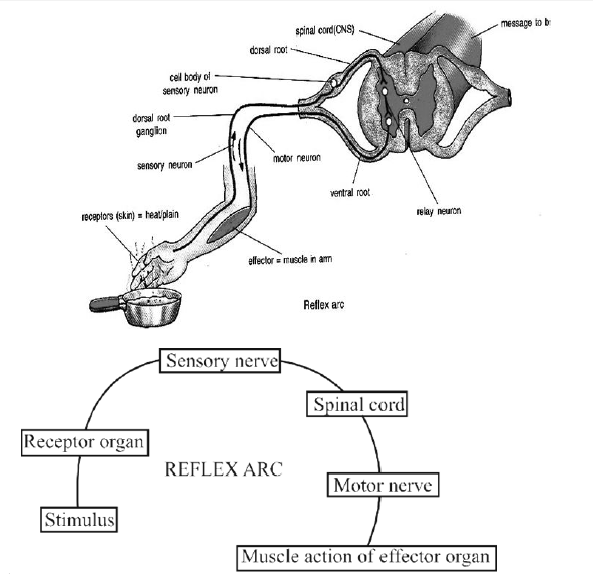
Examples:-
(i) Watering in mouth on sight of food
(ii) Closing of eyes when flashed with strong light.
(iii) Withdrawal of hand when pinched with a needle.
(iv) Blinking of eyelids, gut peristalsis, yawning, sneezing, coughing.
Peripheral Nervous System:-
- All the nerves arising from brain and spinal cord are included in peripheral nervous system.
- PNS consists of two sets of nerve:-
(A) Cranial Nerves:-
- Nerves arising from brain are called cranial nerves.
- Nerves may be sensory, motor or mixed.
- 12 pairs of cranial nerves are found in reptiles, birds and mammals but amphibians and fishes have only 10 pairs.
(B) Spinal Nerves:-
- Nerves arising from spinal cord.
- Each spinal nerve is mixed type and arises from the roots of the hornsof grey matter of the spinal cord.
- In human only 31 pairs of spinal nerves are found.
Autonomic Nervous System (ANS)
- The autonomic nervous system is that part of the peripheral nervous system which controls activities inside the body that are normally involuntary.
- ANS plays an important role in maintaining the constant environment. (Homeostasis)
- There are the two divisions of the ANS:-
(a) Sympathetic nervous system
(b) Para sympathetic Nervous system
(a) Sympathetic Nervous System:-
SNS is related with those such visceral reactions, which increase the protection of
body in adverse atmospheric conditions.
(b) Para sympathetic Nervous System:-
- PNS is related with those reactions in which energy is conversed.
- In this way, ANS controls the activities of visceral organs double sidei.e. antagonistic to each other.
Cerebrospinal Fluid (C.S.F.):-
- This fluid is clear and alkaline in nature just like lymph.
- C.S.F is present in ventricle of brain, subarachnoid spacebetween arachnoid and piameter and spinal cord.
- It acts as shock absorbing medium.
- Broca’s area: It is motor speech area, present in frontal lobe of cerebrum. If it get destroyed the animal becomes unable to speak.
- In human brain more than 100 billion neurons are present. Ÿ In mammals the speed of nerve impulse is 100-130 m / sec. Ÿ White matter: It is composed of medullated nerve fibres.
- Grey matter: It is composed of cytons and non medullated nerve fibres.
Endocrine system: Glands made up of specialised tissues called endocrine glands, are found in our body. The special chemical substances ‘hormones’ are secreted by these glands which catalyze and control various biological process. These glands secrete hormones directly to the blood so these glands are also called ductless glands.
These glands are located in different parts of our body. Our main endocrine glands are as follows
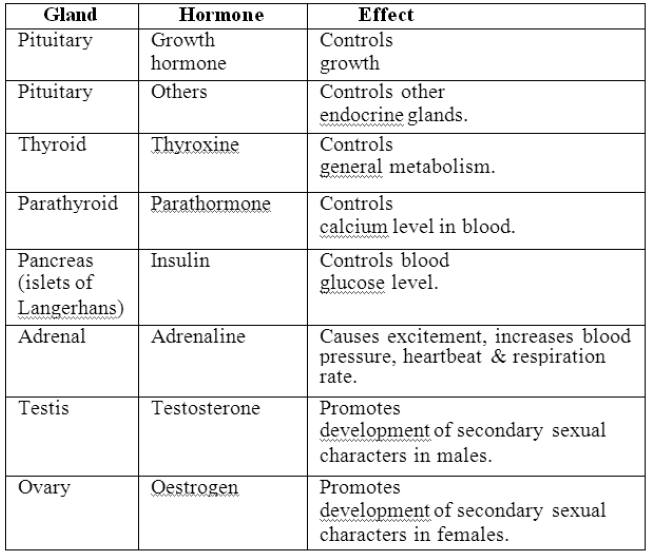
COORDINATION IN PLANTS
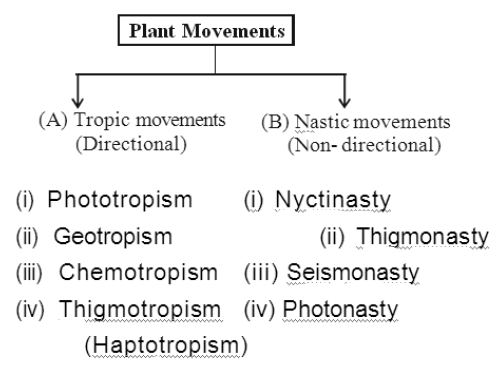
(A) Tropic movements:- They are directional growth movement of curvature in which the direction of movement is determined by the direction of stimulus
(i) Phototropism:- It is directional growth movement of curvature which occurs in response to unidirectional exposure to light.

(i) Chemotropism:- It is directional growth movement of curvature that occurs in response to a chemical stimulus.
e.g. – Movement of pollen tubes and fungal hyphae.
(ii) Hydrotropism:- It is a directional growth movement of curvature which occurs in response to unilateral stimulus of water. e.g. – Root of seedlings.
(iii) Thigmotropism (Haptotropism):- It is directional growth movement of curvature which occurs in response to stimulus of contact.
e.g. – Tendrils, haustoria of Cuscuta.
(B) Nastic movements:- The movement of plant parts in response to an external stimulus in which the direction of response is not determined by the direction of stimulus is called Nastic movement.
(i) Nyctinasty:- Sleep movements – Due to day and night. e.g. – Daily movement of flowers, leaves, stomata.
(ii) Thigmonasty or Haptonasty:- The non directional movement of plant part in response to the touch.
e.g. – Tentacles of insectivorous plants.
(iii) Seismonasty:- The turgor changes occur in thin- walled cells of pulvinous, causing
folding and drooping of the compound leaves.
e.g.- Mimosa pudica (Touch me not plant)
(iv) Photonasty:- The non directional movement of plant part in response to light. e.g.- Dandelion flower
Chemical Coordination in plants:-
The function of control and coordination in plants is performed by certain growth regulators,which are also referred to as plant hormones or phytohormones. The phytohormone is an organic substance produced naturally in plants, controlling growth and other functions at a site remote its place of production and active in minute amounts.
- First plant hormone, discovered by Went was auxin.
- A phytohormone can be defined as a chemical substance which isproduced naturally in plants and is capable of translocation and regulating one or more physiological processes.
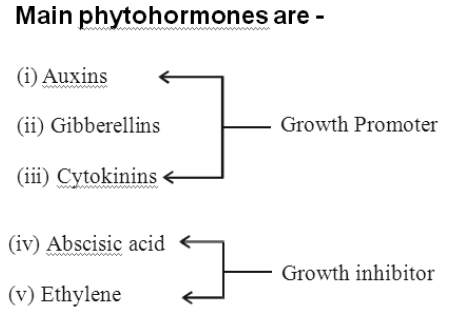
Question: Neurohumors released by the terminal branches of neurons are –
a) Acetylcholine and noradrenaline
b) Sympathin and thyroxine
c) Acetylcholine and cholinesterase
d) Cholinesterase and noradrenaline
Answer: a
Question: Cortisone is used for the treatment of inflammation, allergy and arthritis. Which of the following endocrine glands produces cortisone –
a) Thyroid
b) Pancreas
c) Adrenal
d) Gonads
Answer: c
Question: Injecting a tadpole with thyroxine would lead to –
a) Giant but normal tadpoles
b) Precocious metamorphosis
c) Stoppage of metamorphosis
d) Atrophy of gonads
Answer: b
Question: At most of the synapses –
a) An electric current jumps a gap
b) There is contact between two neurons
c) Heat is produced
d) Neurohumors or neurohormones are released
Answer: d
Question: The cerebellum is concerned with –
a) Coordination of muscular movements
b) Memorization of facts
c) Perception
d) Regulation of the working of the heart and lungs
Answer: a
Question: Reflex action in a body is not –
a) Inborn
b) Automatic and quick
c) Protective in nature
d) Voluntary
Answer: d
Question: The amount of glucose in the blood is controlled by –
a) Water
b) Combined action of insulin and adrenaline
c) Adrenaline alone
d) Insulin alone
Answer: b
Question: A very high level of calcium in the blood suggests malfunction of the –
a) Parathyroid
b) Thyroid
c) Thymus
d) Adrenal gland
Answer: a
Question: Production of ADH, monitor of temperature and blood pressure, is mainly controlled by –
a) Cerebellum
b) Cerebrum
c) Hypothalamus
d) Medulla
Answer: c
Question: The number of cranial nerves is –
a) Ten pairs in man and ten pairs in a toad
b) Thirteen pairs in man and ten pairs in a toad
c) Twelve pairs in man and ten pairs in a toad
d) Twelve pairs in man and twelve pairs in a toad
Answer: c
Question: Learning, abstract thinking, memory and behaviour of a person are governed by –
a) Cerebellum
b) Cerebrum
c) Thalamus
d) Medulla
Answer: b
Question: The two systems that regulate the activities of other systems of an animal are –
a) Nervous system and muscular system
b) Endocrine system and respiratory system
c) Nervous system and endocrine system
d) Muscular system and sense organs
Answer: c
Question: The following are not the functions of medulla of the brain –
a) Control of voluntary actions, memory and judgement
b) Respiration and coughing
c) Circulation and heart beat
d) Swallowing and vomiting
Answer: a
Question: Dorsal nerve cord is characteristic of –
a) Earthworm
b) Hydra
c) Amoeba
d) Primates
Answer: d
Question: In which direction does the nerve impulse travel once it is received by the receptor?
a) Terminal branches, axon, cell body and dendrite
b) Dendrite, axon, cell body and terminal branches
c) Axon, dendrite, axon, cell body and terminal branches
d) Cell body, axon, dendrite and terminal branches
Answer: b
Question: Islets of Langerhans produce –
a) Insulin and secretin
b) Glucagon and adrenaline
c) Insulin and glucagon
d) ACTH and noradrenaline
Answer: c
Question: Proprioceptors are –
a) Meant for detecting pressure in the skin
b) For magnifying sound in the internal ear
c) Internal sense organs which occur most frequently in muscles
d) For the detection of direction of waves in fishes
Answer: c
Question: The effect of myelin sheath on an impulse is –
a) To affect the speed of the incoming impulse
b) To moderate the speed of the incoming impulse
c) To increase the speed of conduction of the impulse
d) It is insulating material and has nothing to do with the speed of the impulse
Answer: c
Question: Maximum developed cerebrum is found in –
a) Sharks
b) Rabbit
c) Man
d) Whale
Answer: a
Question: The type of behaviour in which a substitute stimulus evokes the same response as the original stimulus is called –
a) Reflex action
b) Conditioned reflex action
c) Operon
d) Habit
Answer: b
Question: The main portion(s) of a neuron is/are –
a) Cyton with dendrites
b) Axon with or without sheath
c) Terminal branch
d) All of the above
Answer: d
Question: Apical dominance means –
a) Supression of growth of apical bud by axillary buds
b) Supression of growth of axillary buds by the presence of apical bud
c) Stimulation of growth of axillary buds by removal of apical bud
d) Inhibition of growth of axillary buds by removal apical bud
Answer: b
Question: Spinal cord passes through –
a) Obturator foramen
b) Condylar canal
c) Sphenopalatine foramen
d) Foramen magnum
Answer: d
Question: Stem elongation is affected by –
a) Gibberellin and florigen
b) Auxin and gibberellin
c) Florigen and kinin
d) Kinin and auxin
Answer: b
Question: Reflex arc is formed –
a) Receptor–brain–muscles
b) Muscles–spinal cord–receptor
c) Receptor–spinal cord–muscles
d) Muscle–brain–receptor
Answer: c
Question: Avena coleoptile test to find out growth promoting hormones was performed by –
a) Went
b) Lysenko
c) Butler
d) Borthwick
Answer: a
Question: The conditioned reflex was discovered by –
a) Watson and Crick
b) Pavlov
c) Morgan
d) Mendel
Answer: b
Question: Thermostat-like function in mammals is controlled by –
a) Cerebrum
b) Hypothalamus
c) Cerebellum
d) Medulla oblongata
Answer: b
Question: Hearing is controlled by –
a) Temporal lobes
b) Cerebrum
c) Hypothalamus
d) Parietal lobe
Answer: a
Question: Which cell stops dividing after birth?
a) Glial cells
b) Epithelium
c) Liver
d) Neuron
Answer: d
Question: The gland whose hormones affect the functions of many other endocrine glands is –
a) Thyroid gland
b) Pituitary gland
c) Pancreas
d) Parathyroid
Answer: b
Question: The largest number of neuron cell bodies in our body is found in –
a) Brain
b) Spinal cord
c) Tongue
d) Retina
Answer: a
Question: Which of the following is NOT a function of neuron?
a) Receive information
b) Conduct a signal
c) Form the myelin sheath
d) Co-ordinate metabolic activities
Answer: d
Question: Hypothalamus controls the following functions of the body, excluding –
a) Sleep
b) Body temperature
c) Osmoregulation
d) Analysis of stimuli received through sense organs
Answer: d
Question: Which hormone is released when a man suddenly sees a tiger?
a) Parathormone
b) Adrenaline
c) Corticoid
d) Thyroxine
Answer: b
Question: Which part of the donor’s eye is used for grafting in order to cure certain cases of blindness?
a) Retina
b) Lens
c) Cornea
d) Iris
Answer: c
Question: The longest cell in the body of an animal is –
a) Osteocytes
b) Neuron
c) Chromatophores
d) Lymph corpuscles
Answer: b
Question: Receptors of pressure present in deep layers of skin are –
a) Krause’s end bulb
b) Meissner’s corpuscles
c) Corpuscles of Ruffini
d) Pacinian corpuscles
Answer: d
Question: The speed at which impulses are conducted increases with –
a) Increasing diameter of the soma
b) Increasing diameter of the axon
c) Increasing number of dendrites
d) Increasing branching of the dendrites
Answer: b
Question: Grey matter of the brain contains –
a) Cell bodies
b) Cell bodies with processes
c) Cell bodies with processes and a large number of synapses
d) Sensory and motor nerve cells
Answer: c
Question: In mammals, the autonomic system is composed of –
a) Sympathetic and parasympathetic nerves
b) Cranial and spinal nerves
c) Brain and spinal cord
d) Medullated and nonmedullated nerves
Answer: a
Question: Which of the following effects of auxins is of wide application –
a) Induction of fruit development
b) Induction of root initiation
c) Prevention of abscission
d) All of the above
Answer: d
Question: Which of the following is not a naturally occurring plant hormone –
a) 2, 4-D
b) Cytokinin
c) Gibberellin
d) I.A.A
Answer: a
CBSE Class 7 Science Control And Coordination Notes
We hope you liked the above notes for topic Control And Coordination which has been designed as per the latest syllabus for Class 7 Science released by CBSE. Students of Class 7 should download and practice the above notes for Class 7 Science regularly. All revision notes have been designed for Science by referring to the most important topics which the students should learn to get better marks in examinations. Our team of expert teachers have referred to the NCERT book for Class 7 Science to design the Science Class 7 notes. After reading the notes which have been developed as per the latest books also refer to the NCERT solutions for Class 7 Science provided by our teachers. We have also provided a lot of MCQ questions for Class 7 Science in the notes so that you can learn the concepts and also solve questions relating to the topics. We have also provided a lot of Worksheets for Class 7 Science which you can use to further make yourself stronger in Science.
You can download notes for Class 7 Science Control And Coordination for latest academic session from StudiesToday.com
Yes, the notes issued for Class 7 Science Control And Coordination have been made available here for latest CBSE session
There is no charge for the notes for CBSE Class 7 Science Control And Coordination, you can download everything free of charge
www.studiestoday.com is the best website from which you can download latest notes for Control And Coordination Science Class 7
Come to StudiesToday.com to get best quality topic wise notes for Class 7 Science Control And Coordination

